We independently evaluate all recommended products and services. Any products or services put forward appear in no particular order. If you click on links we provide, we may receive compensation.
It’s a mild, summer day. Looking across the field, in the distance, is the Quabog River. Sitting under the Northern Red Oak tree, feeling the breeze quietly pass by, you think of the knife in your pocket. You pull it out, and it reminds you of how the design of the knife parallels the simple scenery in front of you. The knife is the TRM Atom, with OD green linen micarta scales. It’s photogenic looks and worn-in denim feel just seem to fall into place in your hand.

Key Specs: TRM Atom
The Blade
The blade on the Three Rivers Manufacturing (TRM) Atom is an absolute joy to use, and to look at. Beginning at the base of the blade near the handle, we have a blade stock thickness of only .09”, that’s flat ground. It’s steel composition is comprised of CPM 20CV, which has been regarded as one of the best all-around steels available today, and is analogous to M390 and 204P.
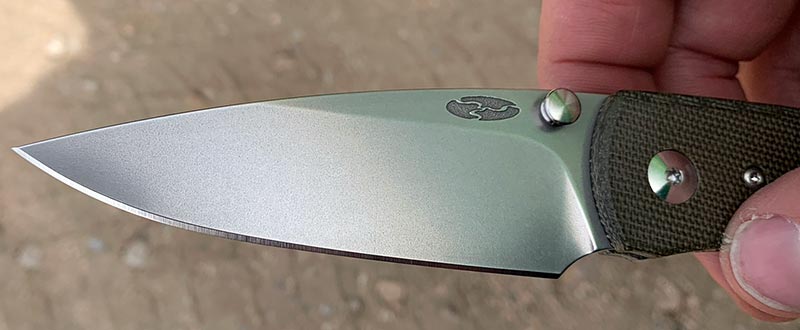
The blade is 3.5” in length, which is a very usable size, and keeps itself within legal blade length limits in most areas (as usual, always know your local laws and regulations). And, its stonewashed, with the absolute finest pattern I’ve ever seen.
When a blade is starting it’s life at just .09”, it’s already ahead of the pack in terms of cutting performance when compared to the bulk of production folding knives available today. But, blade stock thickness is only dubbed as a good cutter, if it’s accompanied by good blade geometry. Which the Atom most certainly is. The thickness behind the edge on this blade is so thin, the best comparison I can imagine making, is to that of a hollow ground blade, or even close to a dedicated kitchen paring knife. This translates to slicing through most everyday-encountered materials akin to using a dedicated box knife with a disposable razor blade. Okay, maybe that’s a bit of a stretch, but it’s really that good.

And CPM 20CV is a steel that is hard to beat. It’s proven to be tough enough to handle some rough use (not abuse, of course), extremely stainless (more so than even S35VN and the like), and holds an edge for a very respectable amount of time. In fact, we find 20CV to be one of the highest ranking stainless steels in terms of edge retention. What’s not to like? Oh, that’s right, sharpening it is a bear, right? Not really, if you’re using most any of today’s available diamond stones. This is the antithesis of a boring looking, drop point, stonewashed knife blade, and it’s great.
Deployment/Lockup
Now to change the tone a little bit. There’s a few things that bother me a little about deploying the Atom. The first, and worst offender, is the thumb studs. Granted, I’m usually more of an opening hole type guy, I can usually be content with thumb studs (especially in the case of the CRK Umnumzaan, what with the rubber O rings and large studs). But these thumb studs seem to have been forgotten in the TRM “attention to every detail” mantra.

It’s not as if the thumb studs will hurt your thumb when using them, but they’re definitely uncomfortable, in a way that I’m reminded of every time I open the knife. And the pocket clip, although great looking and minimalist in design, tends to slip around from side to side with minimal effort, which is presented in my personal use when deploying the blade. I’m one who tends to use the pocket clip as leverage (you probably do too, whether you’ve noticed it or not), and it moves around a fair amount in deployment.
But I digress. These are potentially opinions that won’t be shared by every user. Moving on to the smoothness of the deployment, I can safely say that these washers, apparently being polished by TRM during their manufacturing, are silky smooth. Opening the knife slowly and deliberately will give you the feedback reminiscent of the bar-setting smoothness of the Chris Reeve Sebenza. The washer size is still fairly small in this knife, since we’re making CRK comparisons here, but it’s okay.
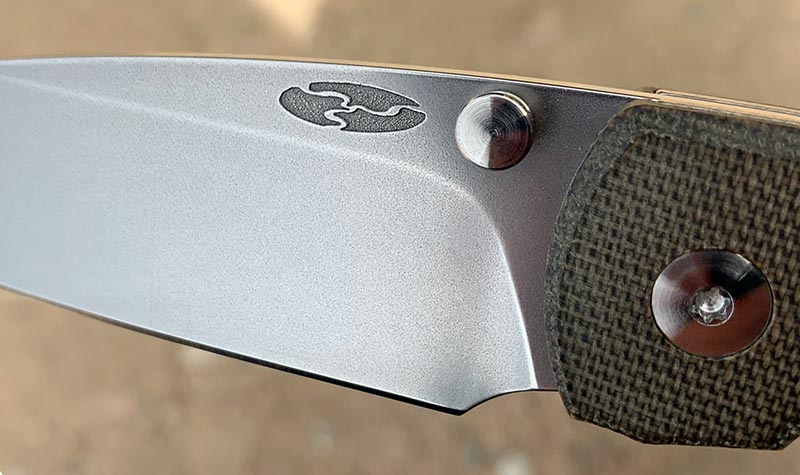
They figured out how to get that slick, frictionless feel in their deployment, without sacrificing rigidity when the knife is locked open. And that last part is somewhat significant. I really don’t think I’ve ever handled a phosphor-bronze washer, pivot system knife that was as solid of a lockup as this, save for the offering from Chris Reeve Knives. And that is where TRM flexes their precision and detail, but keep their prices very fair.
Liner locks are not always my favorite. Of course they work well, assuming the lock interface is accurate, but there’s an aspect of the Walker Liner Lock that tends to bother me in terms of ergonomics. The lock bar usually has two issues for me; the first being the fact that they can sometimes be accidentally manipulated in a very tight grip, and the second being the fact that they usually make too much contact with my index finger, and create a hot spot. These two common occurrences with liner locks again may be particular to the user, but they almost always present themselves to me.

The liners on this knife are also very, very thin. Again, the argument could be made, that with the tight-natured lockup of this knife, and in a normal day-to-day use knife, that’s not inherently a problem in any way. But it gives me this mental pause, that is admittedly a knife guy’s OCD-natured thought process, but it’s still there. Especially when I know that if I grip the handle tightly enough, I may disengage the lock. However, unlocking the knife is very easy, presents zero lock stick, and the knife closes just as smoothly as it opens. And, in the closed position once again, the detent is very respectable.
With a lighter blade in weight, and a detent that is very crisp and seemingly very strong, this blade cannot be shaken out. Once again the OCD comes in to ask a ridiculous question, that will likely never be an issue, but it’s something I try on every knife I own and review. And almost every folding knife I’ve ever handled, I can get the blade to shake open. But not on the Atom, and I really gave it hell.
Features, Fit and Finish
The TRM Atom is, as you may have guessed by this point, a knife with fantastic fit and finish. Other than that semi pesky thumb stud, I really can’t find much that isn’t done right, or at least done objectively well. Boasting nested titanium liners, the knife has a very subdued look, that is easy on the eyes. Having nested liners, meaning metal slabs that are made to fit within a pocket of the handle scales, gives a folding knife a great amount of rigidity. The Spyderco Paramilitary 2 has this feature as well, and most of us knife nerds have had the opportunity to handle one of those.

Nested liners also helps keep the weight down, which, by the way, is a very fitting 3.0 oz. There’s a general rule of thumb when it comes to folding knives and their weight, and that is, the blade length and weight should be very close. For example, a 3.5” bladed knife should have a weight in the ballpark of 3.5 oz. And the TRM Atom beats that, with a weight half an ounce lower than it’s blade length. All this means is, the knife is very light in hand, without having the feel of a plastic toy. It’s well balanced, and the quality can be felt in your hand.
The hardware used on the Atom is something of importance, too. The pivot and screws, which are made from 17-4 PH condition H-1150, have a tensile strength of 135,000 pounds. Of course, that’s just some “sciency” stuff to make it sound amazing, but hey, who could argue with having some exceptionally strong screws and pivot in their folder? And, if that wasn’t special enough, the thumb studs and barrel spacers are made from 6AL/4V titanium. Again, getting “sciency”, but having a $200 price tag in a plain Jane looking folder has to have something special to it, right? And to top off the hardware list, the pocket clip is also titanium, to keep that spec list going.
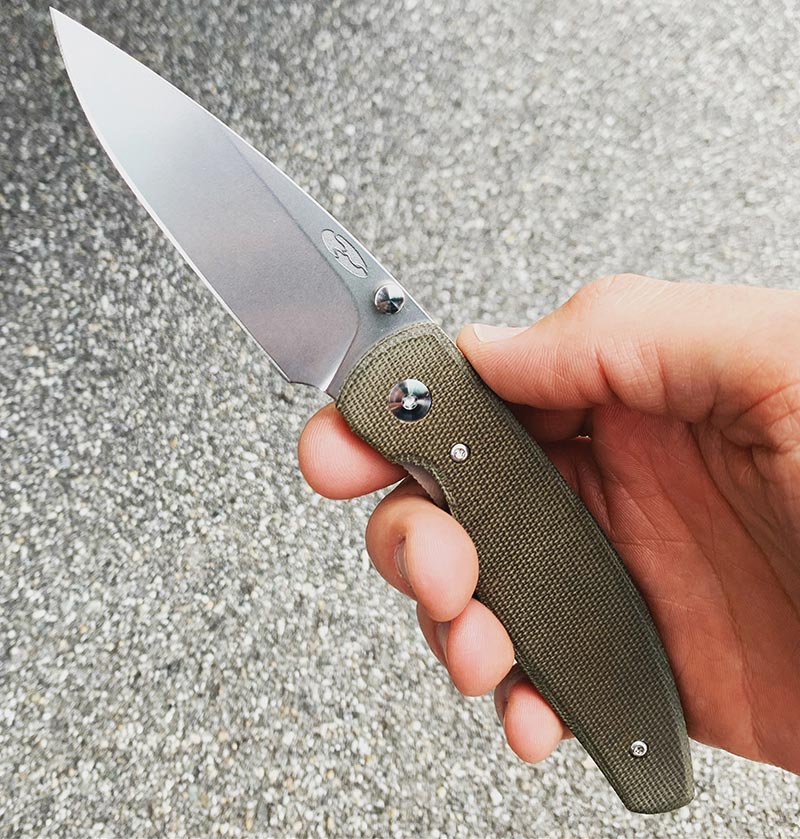
Digging out of the spec list wormhole, and moving back to the visible parts of the knife, the handle scales are very unique on this knife. They are chamfered on all edges, keeping the handle from being too blocky in hand. And they have a feature that just about nothing else I’ve seen has – the ability to be removed and replaced without taking the knife “apart”. What I mean by that is, by taking the two T6 screws out of the show side scale, and the three T6 screws out of the clip side of the handle, the scales come off the knife.
TRM sells a sweet little list of optional scales for their Atom (and other models), and this unique feature allows quick scale swapping, if you’re into that sort of thing. Not having to remove the pivot screws is really nice, because who wants to readjust their perfectly dialed pivot tension, and remove a blade just to swap scales? I’ll admit, it is nice to be able to change the look and feel of your knife from time to time. Don’t we all wish we had a different scale material or look from time to time? I know I do, and this feature makes it quick and easy to dress your EDC buddy in a new outfit in record time. I’m reminded of a certain superhero who jumps into a phone booth, and…. Well, you get the idea.
The construction of the knife is great, with a decent sized pivot, two scale screws in one side, and 3 in the other. But under the scales is another set of screws, including the pivot screw (which is captive, props to TRM here), and three extremely annoyingly constructed barrel spacers. Of course, this is only something to complain about if you’re taking the knife completely apart, but I’m one to do this from time to time for routine cleaning and maintenance.

The issue with the barrel spacers is that they are free to move wherever they want once the screws are removed. And, the screws don’t thread into the barrel spacers (like they should, in my humble opinion). So, you take the knife apart, and then you have to line up three separate spacers, all while holding the knife together. Lets just summarize that into a reassembly that almost necessitates three hands.
Three Rivers, three barrel spacers, three hands. Hmm, I guess it makes sense…But, to me, the bigger potential issue is the unlikely event of cross threading the screws into the opposing liner. These are very small screws, and if you’re not careful, you could end up with an even more frustrating situation here. Again, not a deal breaker, not a huge deal. But it’s something you should know.
One last feature of the Atom I’d like to touch on is the milling in the handle scale for the pocket clip. This is not something you see on many knives. It’s a unique touch, that shows the care and quality in the knife’s design and implementation. It allows the folded over pocket clip, which is semi deep carry, to sit closer to the handle than if it was just planted on the handle scale in a flush mounted nature.
But, to further nitpick a great design cue, the pocket clip screws are not inset into their respective screw holes. This means that the screw heads will inevitably scrape across the pocket when drawing the knife from the pocket. This may only be an issue on certain types of pockets, but I’d venture to say most pocket knife carriers are wearing jeans a good majority of the time, with a moderately heavy pocket lip. And that’s where you may feel a hitch in getting the knife out of the pocket, or sliding it back in.
Field Test
If you’ve ever used a Spyderco Delica, you probably have a good idea of how the Atom performs. These two knives have the same blade stock thickness, but the Atom is about a half an inch longer in blade length.

To test the edge geometry of a knife, I like to run the blade through a few simple tests. They are, the apple slice, cardboard cutting, and 2×4 wood shaving. These three simple tests give a good idea of the knife’s ability to do daily tasks, and give a good sense of the overall ergonomics and use in general. With this knife’s thinly ground blade, I can confidently say I don’t notice much of a difference than when using a standard kitchen paring knife.

And of course, that’s a good thing. I was able to push the blade straight down the side of the apple, without using any sawing type motion, and ended up with a perfectly clean cut off the core. I went ahead and cut up the rest of the apple, and made slices thinner than you’d every want them to be. This thing slices like a dream. And, with that great 20CV blade steel, there’s almost no worry of patina or staining on the blade, even with more citrusy and acidic foods.
Moving on to the ever popular cardboard cutting. Just about any folding knife will cut cardboard, of course. But initiating that cut can vary from knife to knife. Some knives are ground so thick near the edge, it feels like you’re pushing the knife into molasses when starting a cut, and the blade will bind up and the handle will push back at you. Not the case with the Atom. With this knife, you’ll be pleased to know that piercing cardboard, as well as slicing it, is very easy and takes very little effort. And the edge will hold its sharpness for quite some time, with that sweet steel composition coming into play again.
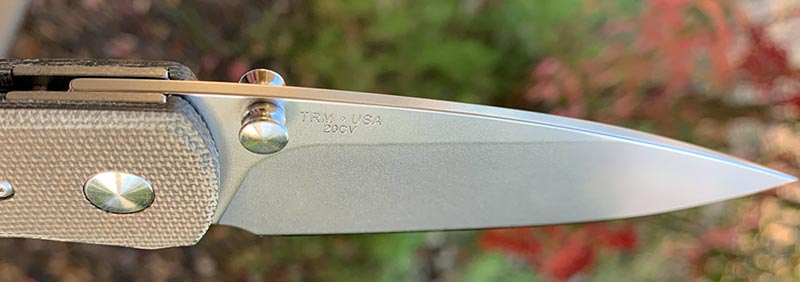
And, when grabbing a 2×4 from the garage, I was able to easily make some very fine feather sticks. No, I don’t really need to make feather sticks, but the optimized blade geometry shows it’s usefulness here again in performance. But, attempt to gouge the wood a little deeper, and you’ll bring out the bad side of this thin little knife. A thin knife, 0.39” in total thickness to be exact, is great to carry and use for light tasks. But, grip it a little harder and try pushing it into some soft wood, and you’ll find it’s greatest downfall. This is where the trade offs come into play.
A light, skinny knife is not one that is good for a moderately tight hammer grip, pushing the blade into a medium. I’m not talking about using the knife as a weapon, which of course should only be done in a last ditch effort by someone with adequate training (probably 1% of us EDC guys). I’m talking about “hard use”, which, to me, is not about battoning my knife or twisting the tip into concrete or rocks. To me, the whole “hard use” terminology gets a bit overused, but when I need to call on my pocket tool to be used for something outside cutting open an Amazon box or an apple, I want to know it’ll serve me well. Can the Atom do these things? Sure, but at the cost of some discomfort and overall performance.
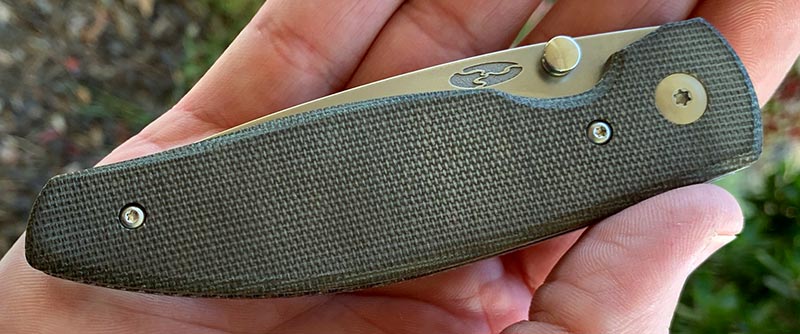
And, one feature that the TRM Atom is lacking, is jimping. I’ll freely say that Spyderco, in certain models like the Manix 2, or Hinderer in the XM series knives, use far too much jimping to far too many places. But with a thin profile on a knife like this, it starts to feel slippery when pushing the knife a little harder, with a little sweat on your hands.
Are all these things relevant? It all depends on the user. Some of us work on construction sites, some in offices, and some, like me, somewhere in the middle of that spectrum. And all knives are not designed for the same purpose. This is possibly debatable amongst keyboard warriors, but put this knife in a roofer’s hand, and he’ll probably break it in a week. But, put it in the hands of your average user, and it’ll fair well. It’s just the way I look at knives, to place them with their target audience. Do manufacturers all want to sell as many knives as possible, to the biggest target market possible? I’m sure they do. And TRM made a good choice here, with a knife that’s designed to fit the EDC role of the majority of pocket knife users.
Alternatives
All these knives available at BladeHQ.
The TRM Atom has a decent price of ~$200 (when they’re in stock, which is basically never). It has some great features, and some great materials. The closest comparable knife, in my opinion, is the North Arm Skaha II. Which is also never available. North Arm is a Canadian small company, and TRM is a Massachusetts based small company. And the knives are priced very similarly, when looking at them with similar options. The Skaha II boasts a 3.25” blade, has a weight of 3.1 ounces, has a liner lock, and similar handle material options (carbon fiber, G10, or micarta on the Atom). And they’re the same price, too.

The Skaha is a flipper, and the Atom is a thumb stud deployment. But, the Skaha rides on bearings, which can be more finicky in terms of smoothness when dirty. And the Skaha, in my opinion, feels a lot worse in the hand than the Atom. The Skaha does have contoured handles, but it feels a bit bulky. And, the jimping on the flipper tab is an index finger killer when the blade is deployed. My biggest gripe with the Skaha was the ability to unlock the knife unintentionally, every time I used it. So, for this reviewer’s tastes, the Atom is a far better choice when comparing to the Skaha.

Dropping far out of the comparable price range, is the recently released Spyderco Endela. It’s an interesting knife, in the sense that it fits directly between the Endura and the Delica in terms of size. And it’s basically the same size as the TRM Atom. Yes it’s a lock back, has VG-10 steel, FRN handles, and is made in Japan, but it’s something to look at, if you’re not willing to wait on a multi-month wait list for an Atom or Skaha, and want some kind of relatable performance. And it’s only $85.

The Spyderco Spydiechef is a very unique knife. It’s a titanium frame lock, running on washers, with LC200N steel, and the knife is quite literally rust proof. And it’s $230. But it’s comparable to the Atom because it’s in the same price range at least, has great cutting performance, and has very similar blade stock thickness and blade length. It’s uniqueness comes in with the blade steel, but also in the blade shape and handle shape. It’s design philosophy is a kitchen companion, doubling as an EDC powerhouse, and comes in at 3.6 ounces. But… it’s widely available at almost any online retailer. There was a time when it was sparse, and hard to find, but Spyderco seems to have figured out how to produce enough of them to keep them in stock nowadays.
Conclusion
Three Rivers Manufacturing is doing great things in the knife world. I have a feeling knife trends are going to swing away from the “hard use”, or tactical folders of yesteryear, and more into the “slicey”, premium material builds we’re seeing here. TRM also holds an important aspect of manufacturing in their company, and that is keeping all parts and materials used, sourced solely in the USA. That’s something that’s very had to do these days, and they do it on all their products. That’s not an important factor for all users, as some may not care, or not be from the USA, but for a majority of us living in this country, it’s a factor in a buying decision.

TRM is doing what a lot of people say we should be doing as a society and as a country. Build here, source here, keep the money here, and keep the quality top notch. It’s the old school “Made In USA” type of a company. They work hard to design great tools, and keep their product top notch, and that’s the reason it’s hard to get these knives. They can’t mass produce and still keep that close attention to detail. They make knives that are great to use for the bulk of our EDC chores, while keeping the price reasonable, and keep their pride in manufacturing and integrity. Let’s keep buying them, and keep this company in business.
- Excellent cutting performance, quick scale swaps, easy to carry, great quality at a fair price.
- Tough to find in stock, some minor fit/finish issues, ergos are a little awkward, a little too thin for heavier use.
TRM Atom
Quality/Performance - 89%
Value for Money - 85%
87%
The Atom is a very well made and executed EDC from an all-American brand, Three Rivers Manufacturing.
Reviewed by Mason Ball





